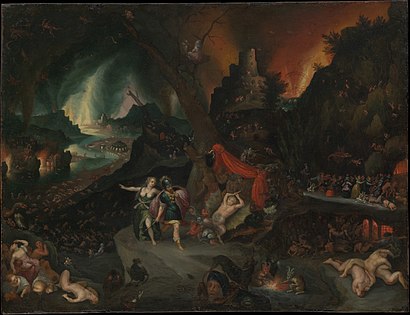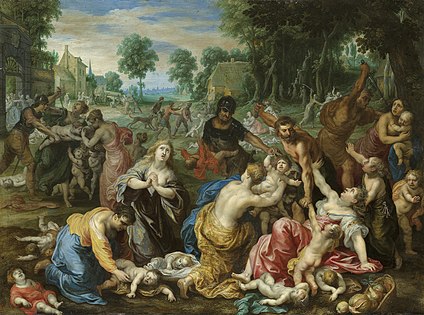Jan Brueghel the Younger

Jan Brueghel (also Bruegel or Breughel) the Younger (/ˈbrɔɪɡəl/,[1][2] also US: /ˈbruːɡəl/;[3][4] Dutch: [ˈjɑn ˈbrøːɣəl] (![]() listen); 13 September 1601 – 1 September 1678) was a Flemish Baroque painter. He was the son of Jan Brueghel the Elder, and grandson of Pieter Bruegel the Elder, both prominent painters who contributed respectively to the development of Renaissance and Baroque painting in the Southern Netherlands. Taking over his father's workshop at an early age, he painted the same subjects as his father in a style which was similar to that of his father. He regularly collaborated with leading Flemish painters of his time.[5]
listen); 13 September 1601 – 1 September 1678) was a Flemish Baroque painter. He was the son of Jan Brueghel the Elder, and grandson of Pieter Bruegel the Elder, both prominent painters who contributed respectively to the development of Renaissance and Baroque painting in the Southern Netherlands. Taking over his father's workshop at an early age, he painted the same subjects as his father in a style which was similar to that of his father. He regularly collaborated with leading Flemish painters of his time.[5]
Life[]

Brueghel was born in Antwerp on 13 September 1601 as the son of Jan and Isabella de Jode. His mother was the daughter of the cartographer, engraver and publisher Gerard de Jode. He trained with his father in his workshop.[6] His father was a friend and close collaborator of Rubens. He likely assisted his father with the execution of large-scale commissions he carried out.[7]
Like his father he traveled to Italy where he arrived around 1621/22. In Milan he was welcomed by Cardinal Federico Borromeo, a patron and friend of his father whom his father had met in Rome about 30 years earlier.[6] In what was likely an act of rebellion against his father, he went to Genoa where he stayed with his cousins, the Antwerp painters and art dealers Lucas de Wael and Cornelis de Wael. Their mother was a sister of Jan's mother. At the time his friend and fellow artist, Anthony van Dyck was also active in Genoa. He worked in Valletta on Malta in 1623. From 1624 to 1625 he also resided in Palermo on Sicily at the time when van Dyck was also working there.[8]

Jan learned about his father's death from cholera after he had returned to Northern Italy in Turin. Wanting to return to Antwerp immediately, he had to delay his departure for 16 days due to a severe fever. After recovering from his illness, he set off for his homeland by way of France. In Paris he met the Antwerp art dealer and painter Peter Goetkint the Younger, who was the son of Peter Goetkint the Elder, the master of Jan's father. Goetkint was eager to return to Antwerp because his wife was expected to deliver a baby soon. The child was born just on 25 August, when Jan Breughel arrived in Antwerp with his traveling companion who himself died a few days later.[6] In the Guild year 1624-1625, Jan became a master painter of the Guild of Saint Luke of Antwerp.[9]
In 1626 he married Anna Maria Janssens, daughter of Abraham Janssens, a prominent history painter in Antwerp.[8] He became dean of the Guild of Saint Luke in 1630. That same year he was commissioned by the French court to paint a series of paintings of the biblical character Adam.[10] In the following years, he also produced paintings for the Austrian court, and worked independently in Paris, before returning to Antwerp in 1657. He collaborated with a number of prominent artists including Rubens, Joos de Momper, Hendrick van Balen the Elder (1575–1632), Adriaen Stalbemt (1580–1682), Lucas Van Uden (1596–1672), his brother-in-law David Teniers the Younger (1610-1690) and his father-in-law Abraham Janssens.[citation needed]
His pupils were his older sons Abraham, Philips and Jan Peeter, his nephew Jan van Kessel, and his younger brother Ambrosius.[8]
Work[]

Taking over his father's workshop at an early age, he painted the same subjects as his father in a style which was similar to that of his father. His repertoire included history paintings, allegorical and mythological scenes, landscapes and seascapes, hunting pieces, village scenes, battle scenes and scenes of hellfire and the underworld. Unlike his father, he did not paint as may flower still lifes. After the death of his father he changed his signature from 'Brueghel' to 'Breughel'.[8]
His best works are his extensive landscapes, either under his own name or made in collaboration with other artists such as Hendrick van Balen the Elder as backgrounds.[5] In view of the strong demand for large decorative landscapes at the time, Jan the Younger would sometimes have his father's works copied and sell them under his father's signature.[5] After Brueghel's death in 1625, Jan Brueghel the Younger took charge of his father's workshop which he operated in the same way as his father. This is clear in the style of the surviving paintings which are in the vein of his father's and the continued collaboration with former collaborators of his father such as Rubens, Joos de Momper and Hendrick van Balen the Elder.[7]
He also collaborated with other Flemish painters of his time, including Hendrick van Balen the Younger, who was the son of his father's collaborator Hendrick van Balen the Elder. Along with his brother Ambrosius, he produced landscapes, allegorical scenes and other works of meticulous detail. Brueghel also copied works by his father and sold them with his father's signature. His work is distinguishable from that of his parent by being less well executed and lighter.[citation needed]
Gallery[]
- Selected works

Flora in the Garden, c. 1630, Kunsthistorisches Museum, Vienna

Aeneas and the Sibyl in the Underworld, c. 1630, Metropolitan Museum of Art, New York

Massacre of the innocent, together with Hendrick van Balen
Family tree[]
| show |
|---|
References[]
- ^ "Brueghel". Collins English Dictionary. HarperCollins. Retrieved 10 August 2019.
- ^ "Bruegel". Lexico UK Dictionary. Oxford University Press. Retrieved 10 August 2019.
- ^ "Brueghel". The American Heritage Dictionary of the English Language (5th ed.). Boston: Houghton Mifflin Harcourt. Retrieved 10 August 2019.
- ^ "Brueghel". Merriam-Webster Dictionary. Retrieved 10 August 2019.
- ^ Jump up to: a b c Jan Brueghel the Younger at the Getty Center
- ^ Jump up to: a b c Frans Jozef Peter Van den Branden, Geschiedenis der Antwerpsche schilderschool, Antwerpen, 1883, pp. 444–455 (in Dutch)
- ^ Jump up to: a b Anne T. Woollett and Ariane van Suchtelen; with contributions by Tiarna Doherty, Mark Leonard, and Jørgen Wadum, Rubens and Brueghel: A Working Friendship, 2006, pp. 5–33
- ^ Jump up to: a b c d Jan Brueghel (II) record on the website of the Netherlands Institute for Art History
- ^ Ph. Rombouts and Th. van Lerius (ed.), De liggeren en andere historische archieven der Antwerpsche sint Lucasgilde Volume 2, Antwerp, Julius de Koninck, 1871, pp. 631, 641, 654, 656, 669, 671 (in Dutch)
- ^ Johnny Van Haeften, Dutch and Flemish Old Master Paintings, Johnny Van Haeften gallery, 2005, p. 11
External links[]
 Media related to Jan Brueghel the Younger at Wikimedia Commons
Media related to Jan Brueghel the Younger at Wikimedia Commons
- 1601 births
- 1678 deaths
- Flemish Baroque painters
- Flemish history painters
- Flemish genre painters
- Artists from Antwerp
- Members of the Antwerp Guild of Saint Luke
- Bruegel family



